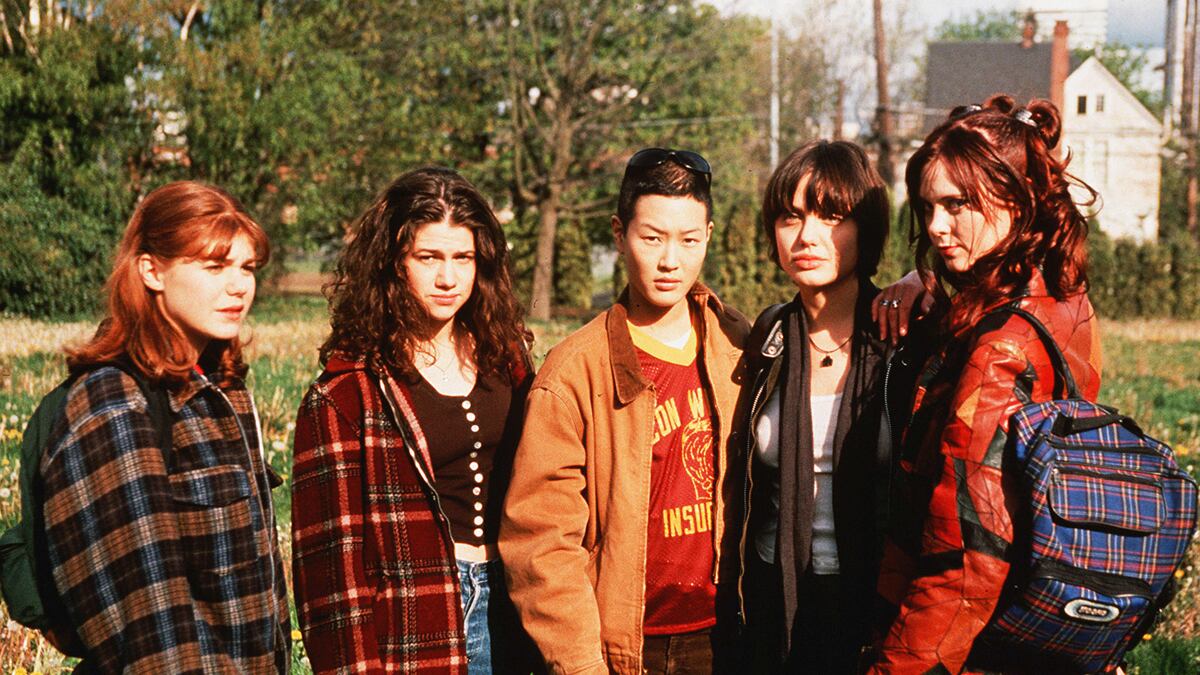Joyce Carol Oates’ novel Foxfire, chronicling a 1950s girl gang in Upstate New York, has nothing to do with Portland. The film adaptation didn’t involve Portland either, until Foxfire director Annette Haywood-Carter started climbing the Broadway Bridge.
The span’s place in the overlooked 1996 teen drama, starring Angelina Jolie and Hedy Burress, hinges on a couple of scenes of youthful aerial abandon above the Willamette. As Haywood-Carter was scouting bridges for her debut feature, she put a credo into practice: “I won’t ask an actor to do something I won’t do.”
Combined with Forest Park’s flora and Lincoln High School’s all-American halls, the film commission representative’s casual go-ahead for the director to climb away sealed the movie’s Portland setting. Months later, a 19-year-old Jolie executed that same climb, hooked to safety cables, well, most of the time.
“Angelina, as you would not be surprised to know, was a bit of a wildass,” Haywood-Carter says of Foxfire’s then-unknown star. “The scene where she goes up on the bridge the first time, we didn’t have her hooked in [yet]. She misbehaved a bit, to the point that the producers asked me to bring her down.”
Just over three years before her Girl, Interrupted Oscar win, Jolie starred as Legs, a magnetic and androgynous drifter (likened by Haywood-Carter to James Dean) who unites four high school girls against a predatory teacher. An ensuing suspension gives the students—high-achieving Maddy (Burress), sexually uninhibited Violet (Sarah Rosenberg), lonely and heroin-addicted Goldie (Jenny Shimizu) and anxious introvert Rita (Jenny Lewis; yes, the future indie-rock idol)—ample downtime to bond in an abandoned river house. Subjectively capturing the elation and intensity of these unlikely friendships remains Foxfire’s strongest attribute, and topless group tattoos by candlelight, dance frenzies and a righteous grand theft auto all follow.
In reality, the gang’s river clubhouse rests on Portland Audubon property, the perfect woodland hideaway, save one production shortcoming.
“I probably picked the only acre in Oregon that doesn’t have trees and then paid $35,000 to have trees flown in and planted,” Haywood-Carter laughs.
The Oregon setting certainly resonates cinematically, as Foxfire shares in the roving, ephemeral love of both Stand By Me and My Own Private Idaho (at once childlike and suggestive), though here with a riot grrrl influence and a soundtrack of Mazzy Star, L7 and the Cramps headlining its marketing.
In adapting a book set in the 1950s, Haywood-Carter recalls pitching the movie’s quintessential mid-1990s edge, having just raised her stepdaughter in that cultural wave.
“This was not a naive generation,” she explains. “This was Columbine era. [Foxfire] was a call and a cry to a culture that was abusive and dangerous for teenage girls.”
That parenting experience may also have helped Haywood-Carter connect with her young actors, especially Jolie, who initially auditioned for Shimizu’s role of Goldie and had to be convinced to take on the wounded, unfettered Legs. A two-hour Wilshire Boulevard coffee meeting, to which Jolie brought six switchblades (trying to choose Legs’ ideal weapon), cinched that decision.
“I think the reason she [initially] said no, this is me guessing, is that the character was too close to who she really was,” Haywood-Carter says.
Twenty-five years after Foxfire flopped, shoveled into a one-week arthouse engagement by a financially flailing MGM, the film resides somewhere between cult and curio. Renewed phone calls from journalists and exhibitors have brought Haywood-Carter delayed affirmation, as it took her 17 years to direct another theatrical feature, 2013′s Savannah.
“[Foxfire] was supposed to be for teenagers,” Haywood-Carter explains. “They didn’t go to arthouse theaters.”
This fall, Haywood-Carter will announce a new film project: a transgender family love story starring trans actors. With hindsight, she wants to emphasize the unlikelihood of a woman directing Foxfire in the first place (even after a decade of script supervision and an endorsement by Steven Spielberg) and how instantly opportunity dissolved after one distribution flub and a savage Variety review.
“I didn’t leave [directing] because I wanted to be a full-time mother or college professor,” says Haywood-Carter. “I left because I couldn’t get any work. My story is a reflection of the times.”
In a sentiment Legs would appreciate, the Foxfire filmmaker can speak frankly to the themes for which her film was apparently 25 years too early.
“Women don’t have to lie about this shit anymore.”
SEE IT: Foxfire streams on Hulu.
